Groups of wolves in central areas of Denali migrate seasonally to northeastern caribou wintering areas, leading to much competition and strife with resident northeastern wolves. Groups in the eastern area generally remain within year-round territories; the more diverse prey base of this area facilitates social adaptations and, predictably, group turnover rates are much lower in this area.
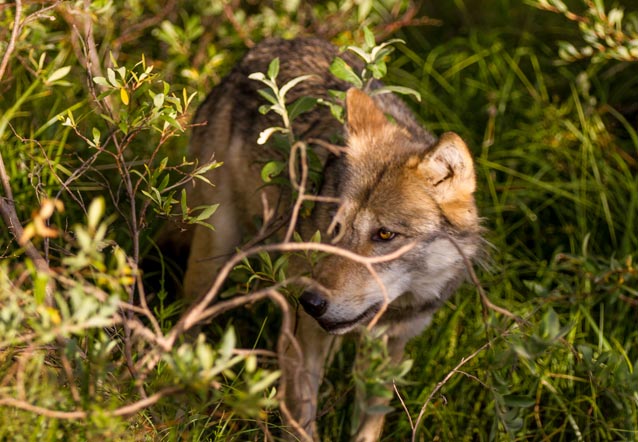
NPS Photo / Alex Vanderstuyf
In Denali National Park and Preserve (Denali), groups of migrating wolves that depend on caribou compete sea-sonally with groups that interact with moose and caribou primarily in fixed areas over annual (biological-year) time steps.
Other groups interact with caribou, moose, and sheep in fixed areas without this seasonal competition (no wolf migrations). Caribou migrate predictably across much of the region for decades, then shift their ranges within the region and to other regions (Haber 1977, Mech et al 1998).
These foraging-related variations provide examples of the multiple- and cross-scale spatial-temporal interactions that characterize systems in general and are important to recognize for research and management purposes (Gunderson and Holling 2002). They can also help to clarify the biological and management significance of wolf social groups. In previous publications (Haber 1996, 1999), I pointed to the decades-old Toklat and Savage groups of Denali in questioning the view that groups are generally short-lived and thus relatively unimportant.
I argued that it is more accurate to think in terms of mixed mosaics of persistent and shorter-lived groups—that groups, rather than populations, are the primary functional units under natural conditions. [A “group” of wolves means a family or extended family in this paper, with the exception of the three as yet non-reproducing and apparently unrelated Eagle wolves in winter 2005-06 (Figure 2)].
Here, I consider details of the Denali foraging variations, what they imply about the varying extents to which the wolves develop and maintain social groups, and the significance of these groups.
Methods
I obtained wolf and prey data by summer ground observation at dens, rendezvous sites, and elsewhere in one of the areas (eastern—Figure 1) from 1966-2006, and by year-round aerial observation throughout all three areas.
My field methods, data analyses, and the study area are described in detail in Haber (1977, 2002); the study area is also described in Mech et al. (1998). The most intensive winter observations were from small aircraft in 1969-1975 and 1995-2006.
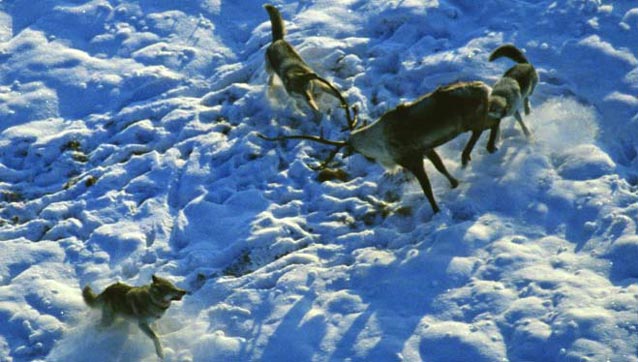
Gordon Haber
I conducted the 1995-2006 winter wolf observations for the most part at aerial radio-tracking locations that amounted to point samples. I conducted the 1969-1975 winter observations during “continuous-interval” samples: I located wolves—primarily two eastern groups, Savage and Toklat (East Fork)—by aerial snow-tracking on as many consecutive days as possible, directly observing them for prolonged periods and searching their intervening trails for evidence of all ungulate kills, winter kills, most ungulate tests, and other behavior. These intervals added up to a total sample of 2,666 miles (4,291 km) of the wolves’ activities across a virtually complete range of winter conditions in Denali (Haber 1977).
I delineated wolf territories subjectively by considering movements, radio tracking locations, behavior (e.g., often more aggressive or more tentative during extraterritorial forays), geographic features, and other field information. The more commonly used “95% minimum polygon” method subjectively excludes 5% of the locations even though many more than 5% could come from extraterritorial forays (Figure 2).
Results and Discussion
Figure 1 highlights three areas of differing wolf foraging patterns—eastern, central, and northeastern—and the territories of 80-100 wolves in 15 groups throughout Denali north of the Alaska Range as of April 2006. Sixty-two of these wolves in eight groups resided in the three areas.
The two major eastern groups maintain year-round territories. They embark on sporadic extraterritorial winter forays, but these are seldom related to any regular ungulate movements and often follow periods of good within-territory hunting success. Sometimes, such as in the early 1970s and at present, a small offshoot group forms in the westernmost area, where ungulate availability is more of a cross between the eastern and central areas (thus the overlap in area boundaries). The current offshoot group (orange territory in Figure 1) embarks on particularly erratic winter extraterritorial forays, and like the early 1970s offshoot, appears unlikely to survive very long (Haber 1977, 2002, present study; Mech et al 1998; Meier et al 2006).
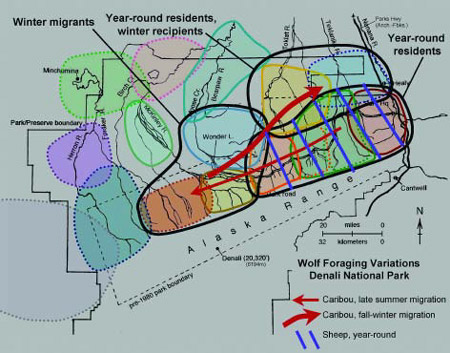
The eastern area coincides closely with the only major sheep habitat in Denali and includes moderate densities of moose that are generally highest in an eastward direction. Caribou migrate into the area during spring and summer and depart primarily to the west by fall. Wolves of this area hunt caribou regularly but sheep lightly, if at all, during summer. They rely heavily on sheep as well as moose the rest of the year, while the caribou are absent (Haber 1977, 2002, present study; Mech et al 1998).
Within the central area, there is usually a higher spring-fall abundance of caribou, albeit with varying major local scarcities. There are essentially no sheep and, other than in the northeastern portion, only low year-round densities of moose (Haber 1977, present study; Mech et al 1998; unpublished National Park Service moose censuses). By early-mid winter in most years, central groups have little choice but to migrate up to 70-80 miles (113-129 km) northeastward, often more than once per winter, to a tradi-tional Denali caribou wintering area (Haber 1977) where they hunt and scavenge moose as well as caribou. Figure 2 shows examples of these northeastward wolf migrations.
Wolves of the northeastern area receive an abundance of caribou most winters but also high-risk competition from the migrating wolves. Numbers of wolves and groups of wolves typically double or triple due to central migrants alone; wolves from the north and probably east add to the total. In winter 2005-06, for example, 21 wolves in three migrating central groups added temporarily to the total of 13 wolves in the two major resident groups. The northeastern wolves do not reciprocate when most of the caribou return to the central area in late winter-early spring (Mech et al 1998, present study), apparently because of spring-summer denning constraints (attending immobile young at dens and rendezvous sites). They subsist on the relative few remaining caribou and low-moderate densities of moose.
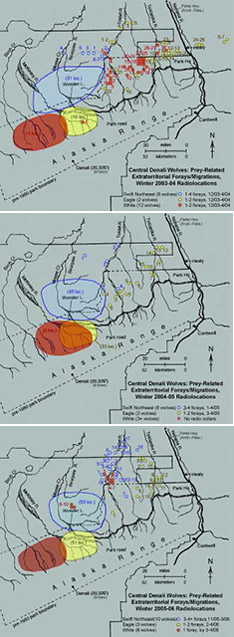
The eastern wolves also maintained year-round territories during my 1969-1974 observations, despite more pronounced seasonal and longer-term caribou declines (Haber 1977). I did not follow the central wolves closely enough in 1969-1974 to determine how they responded to these changes. Figure 3 summarizes details of the eastern responses to the larger pre-1971 seasonal caribou departures and the final stage of an overall decline from at least 20,000-30,000 caribou in the 1920s-1930s to 8,000-9,000 in the 1950s-1960s to the current low stable state of 1,000- 3,000 as of 1972.
Toklat was well established when I began my research in 1966 and is still present (Figure 1, green eastern group). National Park Service biologists, pilots, photographers, and others have also observed Toklat regularly since the late 1970s, and this group has been radio-collared continuously since 1986. Savage likewise was well established when I began my research in 1966. The 12 Savage wolves disappeared in winter 1982-83 while there were indications of possible illegal aerial hunting but not of any natural causes. Savage ranged east of the Toklat territory, within a larger version of the reddish territory shown in Figure 1.
When caribou numbers decreased to about 3,000 in 1971, there was an obvious summer scarcity of caribou for the eastern wolves, especially Toklat, compared to at least the previous five years. This was due to an abbreviated (more pulsed) westward migration from the then major southeastern calving area as well as the actual decline (Haber 1977). The vertical dashed lines in Figure 3 identify this threshold.
Toklat changed in major social ways during this period. Before 1971, Toklat began the winters at a larger size and lost more wolves by the end of each winter. It had a loose social structure year-round; two males even seemed to be “co-alphas.” During these winters there were frequent separations into two or three temporary subgroups of varying combinations, most of which (75-100%) included experienced adults. Subgroups hunted the lower densities of resident moose and sheep and scattered remaining caribou in different areas of the 1,000-square-mile (2,600 km2) territory. By summer 1971, one of the two co-alpha males and at least two other adults or yearlings formed the offshoot (“Wonder Lake”) group noted earlier in the western third of the territory (Haber 1977), somewhat west of where the current Toklat offshoot formed in 1996-2003.
Toklat began each of the next two winters at a smaller size but was more cohesive (only about one-third as much temporary winter splitting) and maintained about the same late winter size. The number of subgroups increased in the third winter (1973-74), but fewer of these subgroups (60- 70%) included experienced adults. This coincided with an increased early winter group size, similar to circumstances of the age-dominance winter splitting in the cohesive Savage group.
Figure 2 Details
Examples of winter migrations, central Denali wolves, 2003-2006. Numbers indicate sequences of migratory locations and (in parentheses) locations within territories. The radio-collared White wolves died in summer 2004 (red-brown group on map). Regular contact was not reestablished with White until the alpha male was collared in March 2006 while this group was on a migration (location 1). Contact was lost again a month later when Swift Northeast (blue) intercepted White in its territory and killed the alpha male (location 10). Swift Northeast shifted eastward into a vacancy created when a smaller group died out in early 2003. (White is also known as Straightaway, Swift Northeast as McKinley Slough, and Eagle as Turtle Hill).
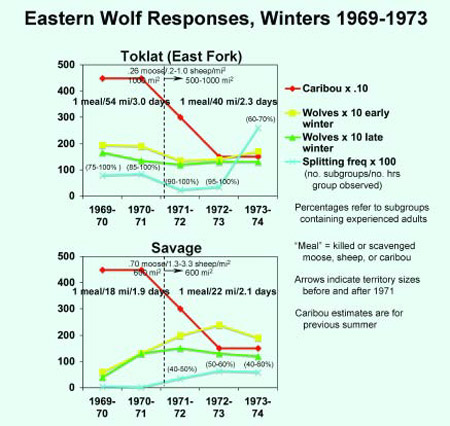
Savage was afforded less access to caribou and thus was less affected by the seasonal and longer term caribou declines. After recovering to a normal size from shooting losses in 1968, Savage maintained a stable late winter size via a form of winter splitting that less often separated the core adults from each other (maintained more cohesion) but more often left young, inexperienced wolves on their own at a disadvantage, such that more died or dispersed. The frequency of this splitting was correlated with early winter group size. Savage’s winter foraging rates (meals/miles/days) changed little if at all during the 1969- 1974 observations. Savage foraged two to three times more efficiently than Toklat amidst two to three times higher moose and sheep densities.
The foregoing suggests that under natural conditions there should be more turnover among the central and northeastern than the eastern groups. The former are subject to high risks from migration-related competition (recipients as well as migrants), and their prey bases are less diverse and of generally lower density. Data from Mech et al. (1998) and the present study indicate that there were 11-14 groups in the central area and 11 groups in the northeastern area over the last 20 years, but only 8-9 in the eastern area over the last 40 years. Each of the three areas usually supports 2-3 groups at a time (Figure 1). Known or likely human impacts (trapping, shooting, collaring deaths) in 1-2 central, 3-4 northeastern, and at least 3 eastern terminations fall well short of accounting for these differences. Migration is a foraging strategy of last resort for Denali wolves from this standpoint, a solution to be expected only when there are no social or other alternatives.
It also follows that the longevity of the eastern groups should facilitate high levels of cooperation.
Cooperative hunting tactics were important to both Savage and Toklat because of the difficulty and danger posed by their physically superior prey, especially moose (Haber 1977). Behavioral observations as well as hunting success rates confirmed that it was usually much more difficult to capture and kill moose and sheep than caribou. Young wolves of these moose- and sheep-oriented groups required prolonged learning (two to three years) for hunt-ing proficiency (Haber 1977). This implies higher overall levels of sociality than in the more caribou-oriented central and northeastern groups.
The eastern groups also exhibited sophisticated cooper-ative breeding behavior, including altruistic helping, although not much is known about any differences in this aspect of their sociality relative to the other groups.
Helpers, typically young females, often assist breeders as an artifact of their own potential direct fitness gains, such as from “practicing” for motherhood or delaying dispersal until resource conditions improve. However, much of the helping I observed in Savage and Toklat also appeared to be altruistic. It was commonplace for high-ranking, experienced males and females as well as young adults and yearlings to assist breeders, and even for breeders to assist other breeders (Haber 1977, present study).
For example, the second-ranking Savage male (Figure 4) was a capable wolf with an obvious desire to mate (Haber 1977). Yet, despite good prey conditions in surrounding areas, for at least three to four of his prime reproductive years he led most of the group’s activities but deferred breeding to the alpha male. If he was the alpha male’s sibling, as I suspected, this was kin selection at work; if he was unrelated, it was likely some form of reciprocity (Clutton-Brock 2002, Nowak 2006). In 2001, two newcomer sibling males from 170 miles (275 km) away took over Toklat less than three months after the established alpha male died during radio collaring (Haber 2002). One became the new alpha. Both closely attended the unrelated dead male’s four pups.
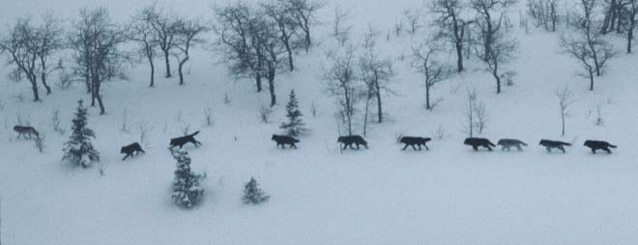
Gordon Haber
Conclusions and Management Implications
The eastern groups of wolves in Denali National Park and Preserve are long-lasting primary functional units with high levels of sociality, apparently including the ability to adjust socially to major prey changes. The central and northeastern groups interact and mix to a much greater extent, last on average less than half as long, probably do not develop comparable overall levels of sociality, and thus are less distinctive as functional units. There is no evidence for any larger-scale wolf functional units, least of all a Denali-area “population.” Data on long range dispersals from Denali (Meier et al. 2006) and other observations indicate that the biological population to which Denali wolves belong covers a much larger area, probably extending all the way to the Arctic Ocean.
Agency wolf management policies are based on a population view, usually without reference to actual biological populations. Management emphasis should shift instead to groups, naturally short-lived as well as persistent. Even short-lived functional units are important in the multi-scale scheme of things at Denali and for systems in general. As recently as 2004-2006, Toklat, Margaret (the latest Savage successor), and two northeastern groups suffered heavy trapping and hunting losses on adjacent state lands in the northeastern area east of Savage River. The importance of park groups that venture temporarily to this area from near and far (Figures 1-2) warrants an immediate wolf trapping and hunting closure.
References
Clutton-Brock, T. 2002.
Breeding together: Kin selection and mutualism in cooperative vertebrates. Science 296:69-72.
Gunderson, L.H., and C.S. Holling. 2002.
Panarchy: Understanding transformations in human and natural systems. Island Press. Washington, D.C.
Haber, G.C. 1977.
Socio-ecological dynamics of wolves and prey in a subarctic ecosystem. Ph.D. dissertation, Univ. of British Columbia, Vancouver.
Haber, G.C. 1996.
Biological, conservation, and ethical implications of exploiting and controlling wolves. Conservation Biology 10:1068-1081.
Haber, G.C. 1999.
A selective view of wolf ecology. Conservation Biology 13:460-461.
Haber, G.C. 2002.
Toklat, Margaret, and Sanctuary: The wolves of eastern Denali. Biological year 2001-02 responses to disruption. Research report, Denali National Park Resource files.
Mech, L.D., L.G. Adams, T.J. Meier, J.W. Burch, and B.W. Dale. 1998.
The wolves of Denali. University of Minnesota Press. Minneapolis, Minnesota.
Meier, T., J. Burch, and L. Adams. 2006.
Tracking the movements of Denali’s wolves. Alaska Park Science 5(1):30-35.
Nowak, M.A. 2006.
Five rules for the evolution of cooperation. Science 314:1560-1563.
Part of a series of articles titled Alaska Park Science - Volume 6 Issue 2: Crossing Boundaries in a Changing Environment.
Last updated: March 16, 2015
